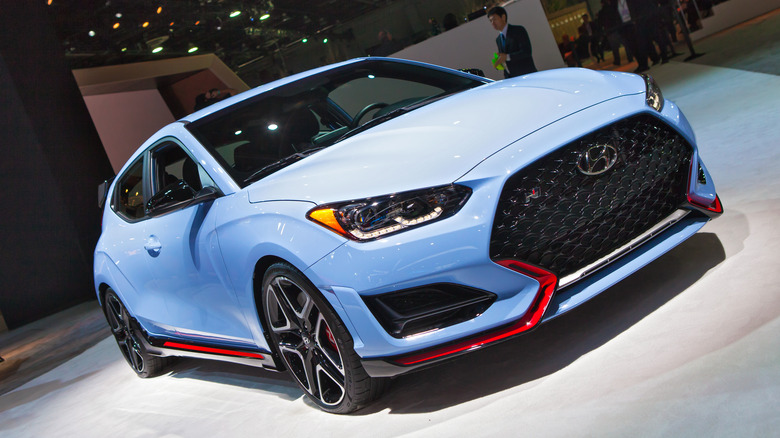
Darren Brode/Shutterstock
The Hyundai Veloster evolved from a 2007 Hyundai concept called the HND-3. The Veloster went into production in 2011 and first appeared in the U.S. as a 2012 model. The first-generation Hyundai Veloster was made for the 2012 through 2017 model years and included a bargain-priced Veloster Turbo version. There was no 2018 Veloster in the U.S. due to a long 2017 model year. The second-generation Veloster was produced in full-line form for the 2019 through 2021 model years. For 2022, only the high-performance Veloster N model was made. A total of 204,000 units were sold in the U.S. during the Veloster’s production run.
The first-generation Hyundai Veloster was based on the Accent’s platform and had a unique way of providing improved access to its small rear seating area. By giving the driver a single, longer door and putting two shorter doors on the passenger side, rear access was improved while still giving the driver maximum space to enter the driver’s seat. Interestingly, Hyundai made both right-hand drive and left-hand drive versions of the Veloster, with the single and dual door sides swapped as appropriate for each market.
Why Did Hyundai Discontinue the Veloster?

Hyundai
The reason that Hyundai discontinued the Veloster is a simple one for those who care about sports coupes and sedans alike. The rise of all things SUV is killing off the sales of these non-utility vehicles. Most of today’s customers who are in the market for a vehicle are more likely to select a larger, boxier, and roomier vehicle that sits you up higher and gives you a feeling of security. The Hyundai Veloster was clearly not designed to meet that brief, N version or not. SUVs and trucks? Bring ’em on!
This can be seen in the product plans of Hyundai itself since the Veloster was dropped. The company introduced the Venue, an entry-level SUV with an MSRP of $19,900, perfectly priced to attract some of those newly SUV-aware former Veloster drivers. The Hyundai Venue is one of 14 individual Hyundai SUVs currently available for sale. For comparison, Hyundai currently offers five sedans, three of which are Elantra models (one of these is the awesome Elantra N). There are no coupes. The trend is clear.
The reasons underlying the demise of the Veloster are an inevitable result of this “SUV all the things” trend. Automakers depend on a certain minimum volume of each model produced to maintain profitability. When the volume drops below that minimum, the model becomes unprofitable and may be axed. The trend to SUVs is being seen worldwide, and Hyundai is simply paying attention to what sells and generates profit. It’s sad but true.
>>> Read full article>>>
Copyright for syndicated content belongs to the linked Source : SlashGear – https://www.slashgear.com/1625045/why-did-hyundai-discontinue-veloster/































